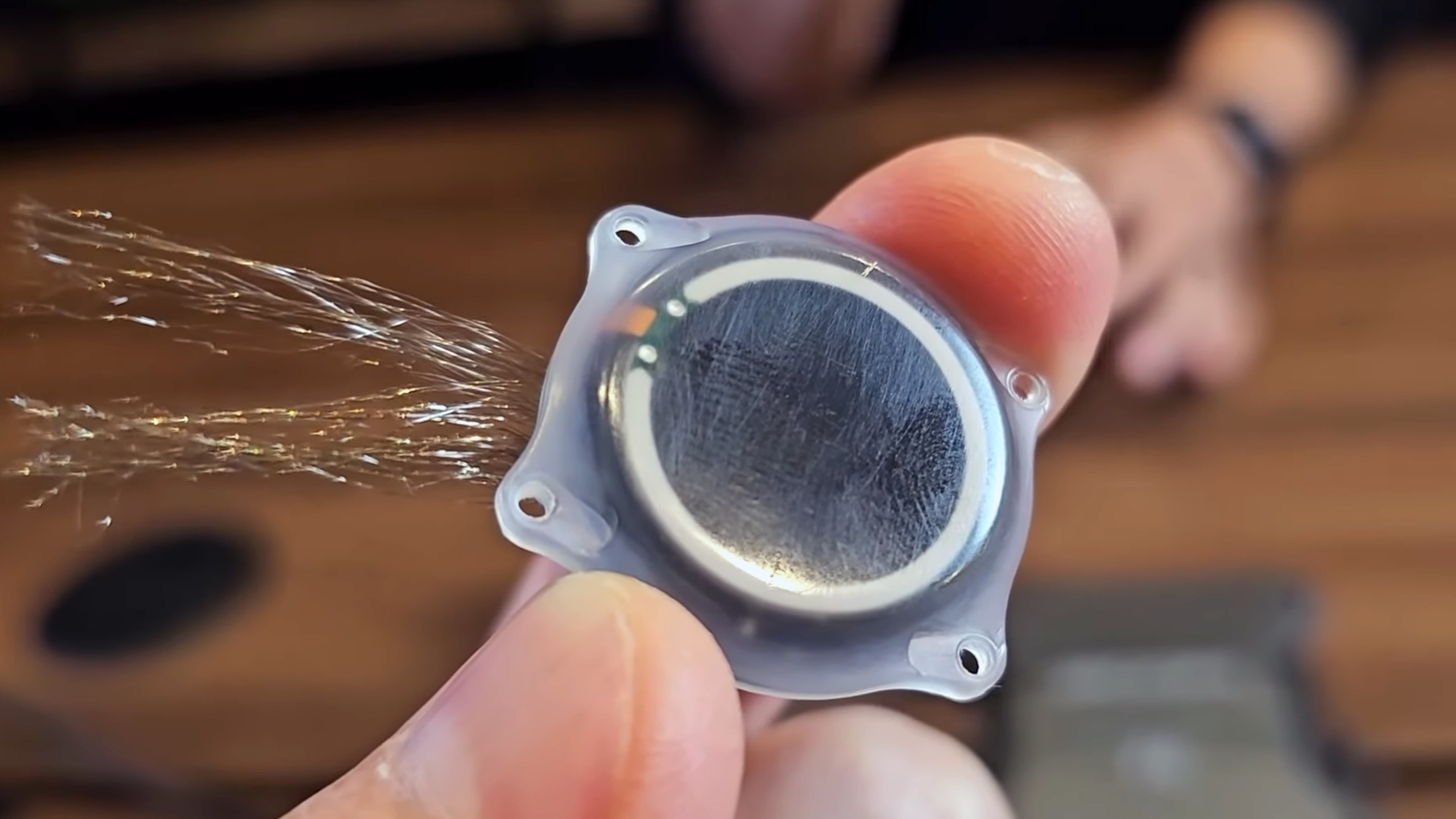Brain interface used to edit YouTube video — paralyzed Neuralink patient also uses AI to narrate with his own voice
Neuralink has allowed some paralyzed patients to regain some control of their lives.

Bradford Smith is just the third patient to be fitted with a Neuralink Brain-Computer Interface (BCI) yet, impressively, advancements in the technology have allowed him to edit and post a YouTube video using just his thoughts. Smith is affected by Amyotrophic Lateral Sclerosis or ALS, a disease wherein the nerves that control his muscles degenerate, which has led to him being unable to move and talk. However, Elon Musk’s investments in Neuralink are finally paying off, and the patient was able to make so many advancements that were previously unheard of.

It was just February last year that the first human Neuralink implantee was reportedly able to move a mouse around by just using their brain. One month later, the patient has grown comfortable enough with the tech that they’re already playing chess and Civilization 6 using the BCI. These achievements are already impressive in their own right, but the second Neuralink patient upped the ante a few months later. In July 2024, Alex, who suffered from a spinal cord injury, received the BCI implant. After a month of getting used to the system, he was reportedly able to use CAD applications to build a custom 3D-printer charging accessory for the implant and play Counter-Strike 2 with his teammates
In the video we embedded, Smith shared what the BCI looked like: a small cylindrical stack about the size of five quarters with several fine electrode threads sticking out of it. It was implanted into his brain by a robot, ensuring that no blood vessels were damaged during the process. From there, the Neuralink connects to a MacBook Pro via Bluetooth, which processes all the neural data gathered from his brain.
Smith noted that the Neuralink is attached to his motor cortex, meaning it can only read his intended movements — not his thoughts and words. Initially, he tried moving his hands to move the cursor, but the system did not respond well. After further study, the engineers working on his implant discovered that moving his tongue is the best way to move the cursor. Bradford said that he doesn’t think about his tongue when moving the cursor, much like how you don’t think about moving your arm or wrist when operating a mouse. His subconscious quickly took over the operation, and he now controls a computer seamlessly through his BCI.
Aside from operating the mouse, the third patient was finally able to regain his voice with AI. Bradford and his team used old video and audio recordings, from before his ALS diagnosis, to train a speech synthesis AI. This allows us to hear him once again, narrating a video which he created himself — something that would’ve been impossible just over a year ago.
BCI technology advances apace
BCI technology is advancing at remarkable speed, with patients now able to use it to operate a computer by themselves. Elon Musk's firm isn’t by any means the only one working on it. For example, a Chinese company was reportedly working on a competing tech called Neucyber in April last year with the backing of Beijing. The government has even started working on a plan to standardize the technology, which would hopefully make it easier for different companies to cooperate.
Advancements in BCIs are helping paralyzed patients get some control over their lives back, allowing them to use computers without external assistance. And as this tech matures even more, maybe we will have a future where ALS and other debilitating diseases would no longer be a life sentence for those affected.
Get Tom's Hardware's best news and in-depth reviews, straight to your inbox.

Jowi Morales is a tech enthusiast with years of experience working in the industry. He’s been writing with several tech publications since 2021, where he’s been interested in tech hardware and consumer electronics.
-
bit_user I always knew brain interfaces were going to be a game changer.Reply
My concern about Neuralink is that they have a very poor track record with animal testing (I mean, not just the fact they do animal testing, which you can't really avoid for something like this, but rather the high "failure rate" among their animal test subjects), in their race to be first. If their human test subjects start to suffer similar fates, I think it's not going to be as easy to brush aside as the traffic deaths of people who misused Tesla's self-driving feature. -
KyaraM Now this is a use AI I can get behind with. But as bit_user said. Just hope that it won't end badly for the people using the device. I'm not a fan of animal testing, and this is one of the more horrific examples of it. It is something that needs especially high ethical standards, which clearly weren't applied.Reply -
Heiro78 Reply
Right there with ya on the animal and human testing. I think it's unlikely to happen with Neuralink, but one of the worst situations with the connected medical tech in this modern age of startups and investor mentality is product retention after company failures.bit_user said:I always knew brain interfaces were going to be a game changer.
My concern about Neuralink is that they have a very poor track record with animal testing (I mean, not just the fact they do animal testing, which you can't really avoid for something like this, but rather the high "failure rate" among their animal test subjects), in their race to be first. If their human test subjects start to suffer similar fates, I think it's not going to be as easy to brush aside as the traffic deaths of people who misused Tesla's self-driving feature.
I have to look it up, but I learned of a woman who had an experimental device place in her head to help with some normally uncontrollable seizures. The device greatly improved her life to the point where she could live a relatively normal life. The company went out of business or bankrupt and out of an abundance of caution (liability), were requiring the removal of the devices. This woman distraught at the idea of returning to that life. To the point where she was willing to sign any an all waivers absolving the company of issues that arise from the device. This was years ago and I gotta find out what ended up happening.
It would be a tragedy if Neuralink implants went the same way or similarly, if an old device became obsolete and servicing it was no longer allowed/ permitted by the company. -
ingtar33 Reply
i think the reason they're doing this with fully paraplegic people is because those are patients with no where to go but up. their life expectancy is not long. there isn't a long life ahead of someone fully paralyzed unless they have the money for full time care. due to the short life expectancy and the zero hope for a future normal life i think anyone in that situation would sign up for the risks willingly.bit_user said:I always knew brain interfaces were going to be a game changer.
My concern about Neuralink is that they have a very poor track record with animal testing (I mean, not just the fact they do animal testing, which you can't really avoid for something like this, but rather the high "failure rate" among their animal test subjects), in their race to be first. If their human test subjects start to suffer similar fates, I think it's not going to be as easy to brush aside as the traffic deaths of people who misused Tesla's self-driving feature.
and the one think no one is talking about is this is the first step toward restoring function to spinal cord injured patients. either through actual bionics or through an interconnection past the damage in the spinal cord. -
bit_user Reply
Worse yet would be if you couldn't continue to afford the service fee, and they disabled it via software. It's not unlike what sometimes happens with prescription drugs.Heiro78 said:It would be a tragedy if Neuralink implants went the same way or similarly, if an old device became obsolete and servicing it was no longer allowed/ permitted by the company. -
KyaraM Reply
That makes it even more important to enforce strict ethics. Unless you see people like this as expendable I guess. The problem is that this can easily be a slippery slope, leading to certain people being labeled as expendable and, thus, appropriate subjects for experiments with high probability of death. Humanity has been there multiple time, we shouldn't go there again. Hence why I say this experiment needs an extra heap of ethics. I would also be careful with that "anyone", honestly; maybe many would do it, but there will always be those who won't.ingtar33 said:i think the reason they're doing this with fully paraplegic people is because those are patients with no where to go but up. their life expectancy is not long. there isn't a long life ahead of someone fully paralyzed unless they have the money for full time care. due to the short life expectancy and the zero hope for a future normal life i think anyone in that situation would sign up for the risks willingly.
and the one think no one is talking about is this is the first step toward restoring function to spinal cord injured patients. either through actual bionics or through an interconnection past the damage in the spinal cord.
And just to avoid misunderstandings, with "you" I don't mean you personally, or anyone here. But in a generalized way. -
bit_user Reply
Even if life expectancy is short, it's not regarded as a terminal illness. In medicine, the "do no harm" ethos should probably take precedence over anything unduly risky.ingtar33 said:i think the reason they're doing this with fully paraplegic people is because those are patients with no where to go but up. their life expectancy is not long.
However, there are risks inherent in any medical procedure. So, as long as the positive outcome is far more likely than negative ones, and the patient is of sound mind and able to give informed consent, I think it's fine. You just can't use their life expectancy as an excuse to treat them differently than any other medical patient. -
ingtar33 Reply
oh i agree. i think what i'm saying is it makes perfect sense to me why a paraplegic person would sign up for this. i know i would if i were in that situation. the idea that one day it might lead to being able to move my body again? or someone else? i would risk it in a heartbeat.KyaraM said:That makes it even more important to enforce strict ethics. Unless you see people like this as expendable I guess. The problem is that this can easily be a slippery slope, leading to certain people being labeled as expendable and, thus, appropriate subjects for experiments with high probability of death. Humanity has been there multiple time, we shouldn't go there again. Hence why I say this experiment needs an extra heap of ethics. I would also be careful with that "anyone", honestly; maybe many would do it, but there will always be those who won't.
And just to avoid misunderstandings, with "you" I don't mean you personally, or anyone here. But in a generalized way.
which is why its important they be extra careful. there is a degree of desperation and fatalism involved in the decision making of patients like that. meaning its on the doctors to make sure that this is safe enough to not harm them. because their tolerance for risk is quite high in a situation like that. sort of a "how can it get worse" type of thing.